The other day, at a store in the mall specializing in such things, I bought a blind-box figurine made by “Happi Class.” Happi Class is a Hong Kong-based designer toy company who say they’re “hoping to transform the things the team likes and find interesting into creative inspiration through different forms of creation.”
The toy I bought was a hamburger man known as Burger Kun, clearly influenced by the hamburger-headed creatures who at one time featured prominently in McDonald’s advertisements and restaurant decorations (in addition to Burger Kun, Happi Class also sell toys based on the hamburger-shaped stools I remember seeing in many-a McDonald’s in my youth). Kun, meanwhile is a Japanese suffix used to indicate someone is a young person. It’s often used in character names, much like chan (for the very young) and san (for adults).
Like many blind box toys, each Burger Kun you buy comes in one of several distinct paint jobs. Burger Kun’s paint jobs are uniquely intriguing, however, because most of them evoke some other pop culture thing, and thereby offer a window into what the Happi Class crew “likes and find interesting.”
I am fascinated by the little cultural games presented by these sorts of things; they invite us to decode allusions to things the creators consider knowable and familiar.
With the help of my fans, I was able to decode the allusions contained in 15 of the 17 Burger Kun paint jobs, which make reference to things from both Asian and American culture.
This is “plain” Burger Kun. On the right, we have a black-and-white version, which is a popular alternative color scheme for designer toys, intended to evoke the black-and-white cartoons of the early 20th century.
This one is based on the Hamburglar, the goofy antagonist of the McDonald’s mascot universe. Debuting in the 1970s, the greedy Hamburger is now perhaps second only to Ronald McDonald as a personification of the world-famous fast food chain.
Based on Obotchaman, a character from the universe of Akira Toriyama (b. 1955), the famed Japanese cartoonist. Obotchaman is the friendly robotic servant of a mad scientist, and appears in two of Toriyama’s best-known works: Dr. Slump and Dragon Ball.
Based on Buzz Lightyear, one of the heroes of Toy Story, the Disney-Pixar franchise. Toy Story (1995) was the first fully computer animated film, and Buzz, a toy spaceman, quickly became a symbol of both the studio that made him and 21st century animation generally.
Based on Super Mario, the hero of the Nintendo video game franchise of the same name. Easily the most famous video game character in history, Mario has appeared in hundreds of games spanning dozens of genres. He’s neither entirely Japanese nor entirely American, but rather an interesting product of cross-cultural collaboration, as I explain in this video.
Based on Donald Duck, probably the second most famous Disney character of all time. Though hardly unloved in America, Donald is even more popular abroad.
Based on the first and third season versions of Kamen Rider, the titular hero from a live-action Japanese TV series of the same name. Created by Shotaro Ishinomori (1938-1998), the visionary behind Power Rangers, the show is an icon of Gen X Japanese pop culture.
Based on Keroppi, a popular merchandise character created by Japan’s Sanrio corporation. Much like his Sanrio sister Hello Kitty, Keroppi can be found all across Japan staring out from pencil cases, notebooks, soap dishes, alarm clocks, cellphone cases, water bottles, and just about anything else made of low-cost plastic.
Based on Zoo Bear, the mascot of Zoo Toys, a Taiwanese store specializing in designer vinyl figurines. A grotesque creation of the Japanese vinyl artist Grape Brain, Zoo Bear figurines have been sold in a variety of colours and styles, much like Burger Kun. Grape Brain is very fond of characters with eyes in the palms of their hands, which evokes the Pale Man, a popular monster from the film Pan’s Labyrinth (2006).
An exclusive version of Burger Kun made for ToySoul 2021, a designer toy convention in Hong Kong. This one is a product of a collab between Happi Class and fellow designer toy brand Milk Cargo. The colors don’t seem to evoke anything in particular and were probably just a design choice.
Based on Chucky, the malevolent star of a series of campy American horror movies. A homicidal doll, Chucky made his debut in Child’s Play (1988) and promptly earned a spot in the pantheon of Hollywood monsters.
Based on Kitaro, hero of the GeGeGe no Kitaro manga and anime series. Kitaro, a one-eyed boy who lives in an occult-themed world filled with traditional Japanese ghosts and monsters, has been one of the country’s most beloved cartoon characters since his debut in the 1960s.
Based on Ampanman, a ubiquitous Japanese cartoon character exceedingly popular with toddlers. Though utterly unknown in the west, Ampanman is an inescapable force in Japanese baby culture, seen decorating strollers, rattles, mobiles, bath toys, and anything else that can’t be easily swallowed.
I was not able to figure out who, if anyone, these two remaining Burger Kun paint jobs were intended to reference. Can you help?


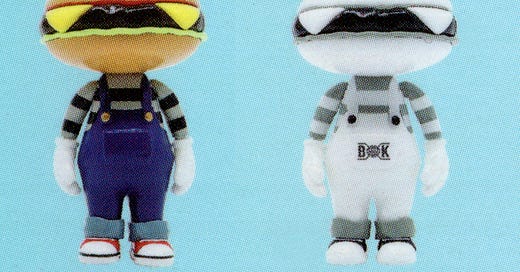




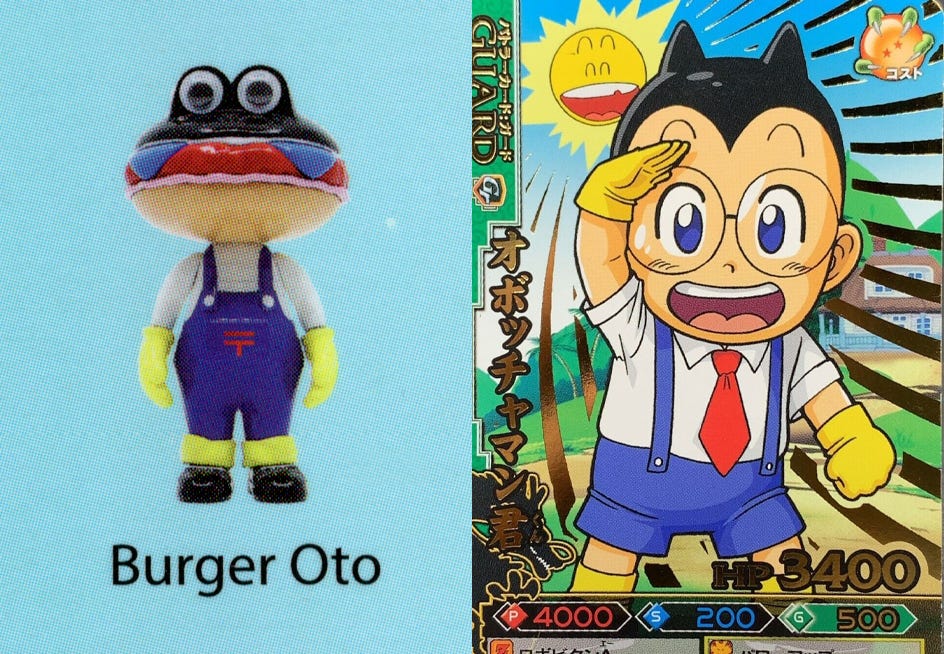
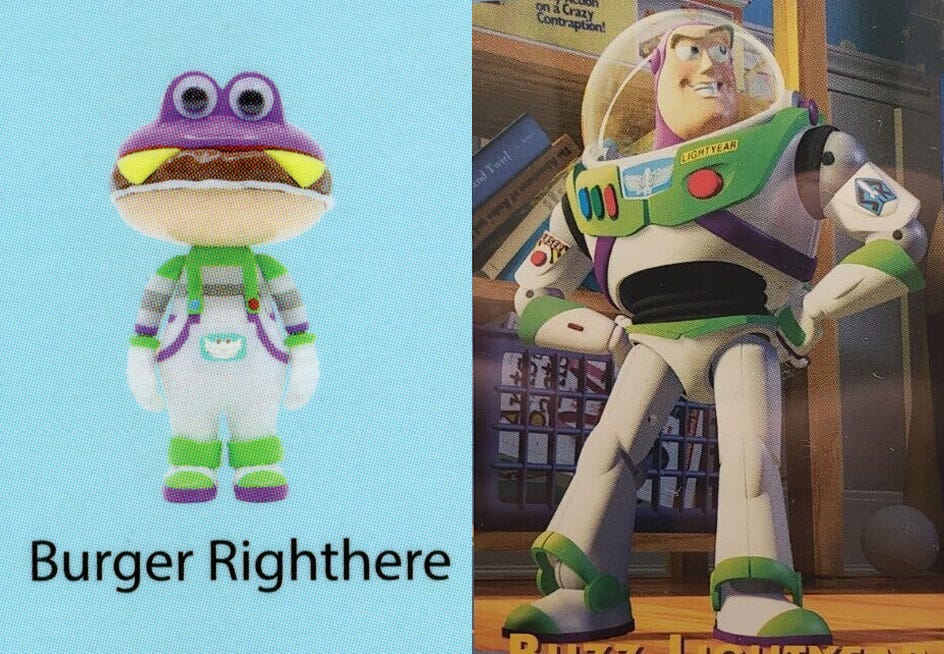




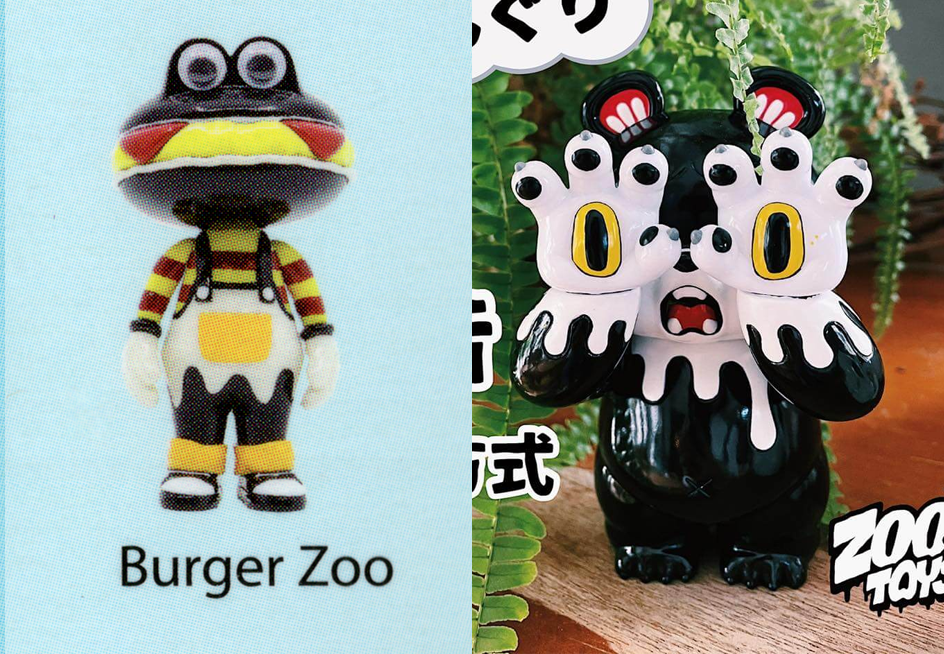



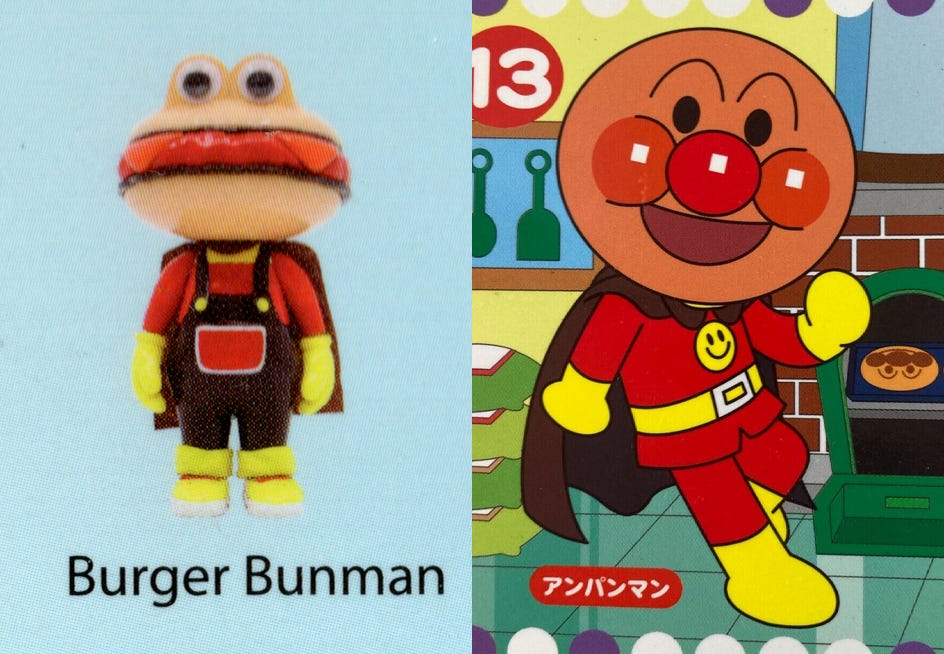

I commented this on the Community Post on YouTube as well but reposting here:
Burger Jermen is Hatsune Miku, the color scheme matches and its card reads:
天生擁有神奇聲帶,只要聽過一次 的聲音,便能照樣模仿,甚至能假 裝出雷过的音頻。
Naturally gifted with a magical vocal cords, can imitate any voice heard once and even can mimic radar audio signals.
The name comes from this fact: Yamaha started development of Vocaloid in March 2000 and announced it for the first time at the German fair Musikmesse on March 5–9, 2003. It was created under the name "Daisy", in reference to the song "Daisy Bell", but for copyright reasons this name was dropped in favor of "Vocaloid".
Thanks for posting. So lighthearted. Nice change for the mind.